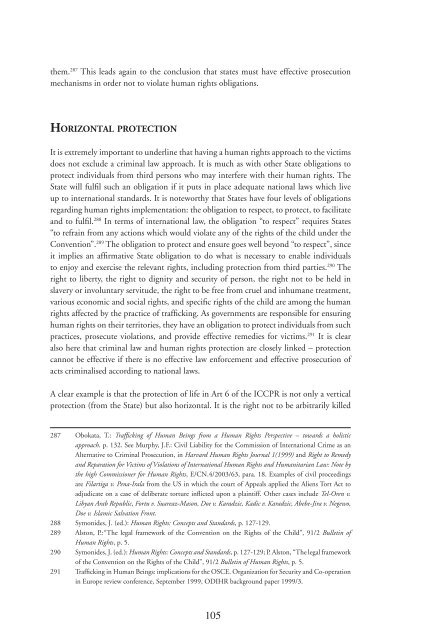Trafficking in human beings: human rights and ... - unesdoc - Unesco
Trafficking in human beings: human rights and ... - unesdoc - Unesco
Trafficking in human beings: human rights and ... - unesdoc - Unesco
Create successful ePaper yourself
Turn your PDF publications into a flip-book with our unique Google optimized e-Paper software.
them. 287 This leads aga<strong>in</strong> to the conclusion that states must have effective prosecution<br />
mechanisms <strong>in</strong> order not to violate <strong>human</strong> <strong>rights</strong> obligations.<br />
HORIZONTAL PROTECTION<br />
It is extremely important to underl<strong>in</strong>e that hav<strong>in</strong>g a <strong>human</strong> <strong>rights</strong> approach to the victims<br />
does not exclude a crim<strong>in</strong>al law approach. It is much as with other State obligations to<br />
protect <strong>in</strong>dividuals from third persons who may <strong>in</strong>terfere with their <strong>human</strong> <strong>rights</strong>. The<br />
State will fulfi l such an obligation if it puts <strong>in</strong> place adequate national laws which live<br />
up to <strong>in</strong>ternational st<strong>and</strong>ards. It is noteworthy that States have four levels of obligations<br />
regard<strong>in</strong>g <strong>human</strong> <strong>rights</strong> implementation: the obligation to respect, to protect, to facilitate<br />
<strong>and</strong> to fulfi l. 288 In terms of <strong>in</strong>ternational law, the obligation “to respect” requires States<br />
“to refra<strong>in</strong> from any actions which would violate any of the <strong>rights</strong> of the child under the<br />
Convention”. 289 The obligation to protect <strong>and</strong> ensure goes well beyond “to respect”, s<strong>in</strong>ce<br />
it implies an affi rmative State obligation to do what is necessary to enable <strong>in</strong>dividuals<br />
to enjoy <strong>and</strong> exercise the relevant <strong>rights</strong>, <strong>in</strong>clud<strong>in</strong>g protection from third parties. 290 The<br />
right to liberty, the right to dignity <strong>and</strong> security of person, the right not to be held <strong>in</strong><br />
slavery or <strong>in</strong>voluntary servitude, the right to be free from cruel <strong>and</strong> <strong>in</strong><strong>human</strong>e treatment,<br />
various economic <strong>and</strong> social <strong>rights</strong>, <strong>and</strong> specifi c <strong>rights</strong> of the child are among the <strong>human</strong><br />
<strong>rights</strong> affected by the practice of traffi ck<strong>in</strong>g. As governments are responsible for ensur<strong>in</strong>g<br />
<strong>human</strong> <strong>rights</strong> on their territories, they have an obligation to protect <strong>in</strong>dividuals from such<br />
practices, prosecute violations, <strong>and</strong> provide effective remedies for victims. 291 It is clear<br />
also here that crim<strong>in</strong>al law <strong>and</strong> <strong>human</strong> <strong>rights</strong> protection are closely l<strong>in</strong>ked – protection<br />
cannot be effective if there is no effective law enforcement <strong>and</strong> effective prosecution of<br />
acts crim<strong>in</strong>alised accord<strong>in</strong>g to national laws.<br />
A clear example is that the protection of life <strong>in</strong> Art 6 of the ICCPR is not only a vertical<br />
protection (from the State) but also horizontal. It is the right not to be arbitrarily killed<br />
287 Obokata, T.: Traffi ck<strong>in</strong>g of Human Be<strong>in</strong>gs from a Human Rights Perspective – towards a holistic<br />
approach. p. 132. See Murphy, J.F.: Civil Liability for the Commission of International Crime as an<br />
Alternative to Crim<strong>in</strong>al Prosecution, <strong>in</strong> Harvard Human Rights Journal 1(1999) <strong>and</strong> Right to Remedy<br />
<strong>and</strong> Reparation for Victims of Violations of International Human Rights <strong>and</strong> Humanitarian Law: Note by<br />
the high Commissioner for Human Rights, E/CN.4/2003/63, para. 18. Examples of civil proceed<strong>in</strong>gs<br />
are Filartiga v. Pena-Irala from the US <strong>in</strong> which the court of Appeals applied the Aliens Tort Act to<br />
adjudicate on a case of deliberate torture <strong>in</strong>fl icted upon a pla<strong>in</strong>tiff. Other cases <strong>in</strong>clude Tel-Oren v.<br />
Libyan Arab Republic, Fortu v. Suareaz-Mason, Doe v. Karadzic, Kadic v. Karadzic, Abebe-Jira v. Negewo,<br />
Doe v. Islamic Salvation Front.<br />
288 Symonides, J. (ed.): Human Rights: Concepts <strong>and</strong> St<strong>and</strong>ards, p. 127-129.<br />
289 Alston, P.:“The legal framework of the Convention on the Rights of the Child”, 91/2 Bullet<strong>in</strong> of<br />
Human Rights, p. 5.<br />
290 Symonides, J. (ed.): Human Rights: Concepts <strong>and</strong> St<strong>and</strong>ards, p. 127-129; P. Alston, “The legal framework<br />
of the Convention on the Rights of the Child”, 91/2 Bullet<strong>in</strong> of Human Rights, p. 5.<br />
291 Traffi ck<strong>in</strong>g <strong>in</strong> Human Be<strong>in</strong>gs: implications for the OSCE. Organization for Security <strong>and</strong> Co-operation<br />
<strong>in</strong> Europe review conference, September 1999, ODIHR background paper 1999/3.<br />
105

















